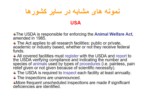بخشی از پاورپوینت
--- پاورپوینت شامل تصاویر میباشد ----
اسلاید 1 :
ضرورت تدوین کدهای اختصاصی پژوهش بر روی حیوانات
رعايت مقررات خاصي كه بر مبناي حفظ سلامت حيوان در طول پژوهش طراحي مي شوند از سويي باعث مي شوند كه حيوان مورد استفاده در طول زندگي در آزمايشگاه از شرايط مطلوب برخوردار باشد و از اين طريق اهداف انسان دوستانه مورد نظر بسياري از مجامع حمايت از حيوانات جلب گردد.
از سويي ديگر سلامت حيوان در طول مطالعه حفظ می گردد تا اثرات سوء و مداخله گرانه بر نتايج پژوهش حذف شوند.
اسلاید 2 :
ضرورت تدوین کدهای اختصاصی پژوهش بر روی حیوانات
در حال حاضر بسياري از مجلات معتبر دنيا براي چاپ مقالاتي كه در طول مطالعه از حيوان زنده استفاده شده، ضميمه نمودن گواهي هاي لازم از مراكز حمايت از حيوانات را درخواست مي كنند.
اوجود فرهنگ عطوفت به موجودات زنده و عدم آزار رساني به حيوانات كه در دستورات ديني ما فراوان وجود دارند نيز ما را وادار مي كنند تا تلاش خود را براي حفظ رفاه لازم براي حيواناتي كه در آموزش و پژوهش از آنها بهره گرفته مي شوند را دو چندان كنيم.
اسلاید 3 :
نمونه های مشابه در سایر کشورها
- MRC Ethics guide, Medical research council, London
- APA’s Guidelines for Ethical Conduct in the Care and Use of Animals
- Australian code of practice for the care and use of animals for scientific purposes 7th Edition, 2004
- ANS MANY OTHERS…
اسلاید 4 :
نمونه های مشابه در سایر کشورها
USA
The USDA is responsible for enforcing the Animal Welfare Act, amended in 1985.
The Act applies to all research facilities: public or private, academic or industry based, whether or not they receive federal funds.
All covered facilities must register with the USDA and report to the USDA verifying compliance and indicating the number and species of animals used by types of procedures (i.e. painless, pain relief given or not given because of scientific necessity).
The USDA is required to inspect each facility at least annually.
The inspections are unannounced.
More frequent unscheduled inspections are made if significant deficiencies are identified.
اسلاید 5 :
USA
All registered facilities are also required to establish a Animal Care and Use Committee (IACUC) that reviews and approves procedures involving animals before they take place, and inspect facilities semiannually for compliance with the AWA.
At least one member of the committee must be a veterinarian.
At least one member must be a "public" member, not affiliated with the institution, who represents the general community interest in the care and treatment of the animals.
اسلاید 6 :
USA
The US Public Health Service has an animalwelfare policy that applies to all federally funded institutions.
The Public Health Service maintains a Guide for the Care and Use of Laboratory Animals. This guide is consistent with and similar to the AWA and applies to all vertebrate animals.
اسلاید 7 :
The Public Health Policy and Government Principles Regarding the Care and Use of Animals states
. Whenever US Government Agencies develop requirements for testing, research or training procedures involving the use of vertebrate animals, the following principles shall be considered; and whenever these agencies actually perform or sponsor such procedures, the responsible institution shall insure that these principles are adhered to:
· The transportation care and use of animals shall be in accordance with the Animal Welfare Act (7USC 2131 et seq.) and other applicable Federal laws, guidelines and policies^1.
· procedures involving animals should be designed and performed with due consideration of their relevance to human or animal health, the advancement of knowledge, or the good of the society
· The animals selected for a procedure should be of an appropriate species and quality and the minimum number required to obtain valid results. Methods such as mathematical models, computer simulations, and in vitro biological systems should be considered.
· Proper use of animals, including the avoidance or minimization of discomfort, distress, and pain when consistent with sound scientific practices, is imperative. Unless the contrary is established, investigators should consider that procedures that cause pain or distress in humans beings may cause pain or distress in other animals.
اسلاید 8 :
The Public Health Policy and Government Principles Regarding the Care and Use of Animals states
- · Procedures with animals that may cause more than momentary or slight pain or distress should be performed with appropriate sedation, analgesia or anesthesia. Surgical or other painful procedures should not be performed on unanesthetized animals paralyzed by chemical agents.
- · Animals that would otherwise suffer severe chronic pain or distress that cannot be relieved should be painlessly killed at the end of the procedure or, if appropriate, during the procedure.
- · The living conditions of the animals should be appropriate to their species and contribute to their health and comfort. Normally housing, feeding and care of all animals used for biomedical purposes must be directed by a veterinarian or other scientist trained and experienced in proper care, handling and use of species being maintained or studied. In any case, veterinary care shall be provided as indicated.
اسلاید 9 :
The Public Health Policy and Government Principles Regarding the Care and Use of Animals states
- · Investigators and other personnel shall be appropriately qualified and trained for conducting procedures on living animals. Adequate arrangements shall be made for their service training, including the proper and humane care and use of laboratory animals.
- · Where exceptions are required in relation to the provision of these Principles, the decision should not rest with the investigators directly concerned but should be made, with due regard to Principle 2, by an appropriate review group such as an institutional animal research committee. Such exceptions should not be solely for the purposes of teaching or demonstration.
- For guidance throughout these Principles the reader is referred to The Guide for Care and Use of Laboratory Animals.
اسلاید 10 :
American Association for Accreditation of Laboratory Animal Care (AAALAC)
- This nonprofit corporation was formed in 1965 by leading US scientific and educational organizations to promote high quality animal care and use through a voluntary accreditation program.
- The animal care facilities of applicant institutions are visited and thoroughly evaluated by experts in animal laboratory sciences, who submit a detailed report to the Council on Accreditation.
- The council reviews applications and site visit reports using the guidelines in Guide for Care and Use of laboratory Animals, to determine whether full accreditation should be granted.
- Accredited facilities are required to submit annual reports on the status of their facilities, and site revisits are conducted at intervals of three years.
- The council reviews the annual reports and site revisit reports to determine whether full accreditation should be continued.









